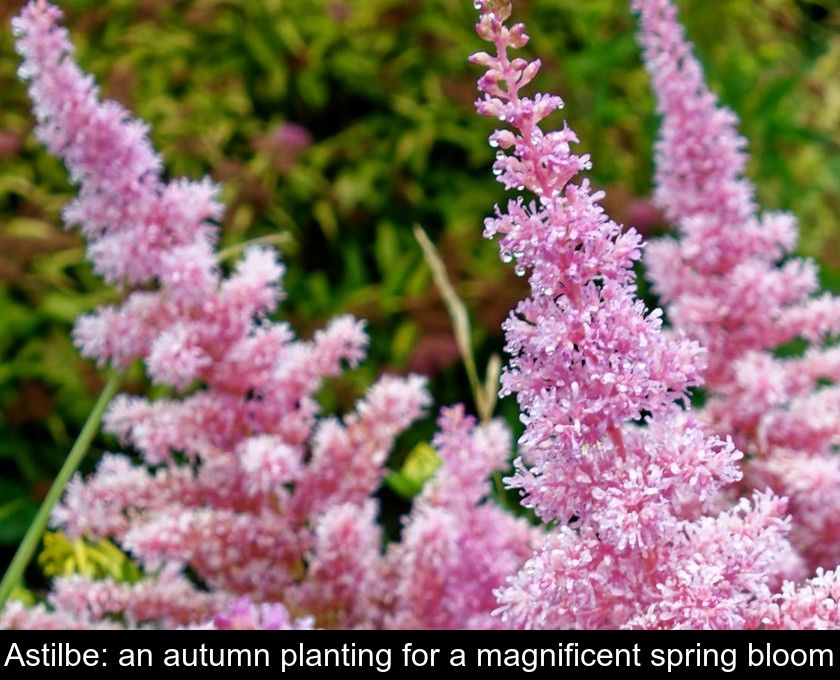Astilbe: An Autumn Planting For A Magnificent Spring Bloom
With its colorful and airy plumes, astilbe is a plant that does not go unnoticed in gardens. But did you know that you can plant it now, in the fall, to enjoy its magnificent bloom in the spring? Here is everything you need to know to welcome this beautiful perennial into your garden.
A bloom as light as a feather duster
Perhaps you have never heard the name astilbe before... But if you have ever seen this plant in full bloom, you surely haven't forgotten it! Plants of the Astilbe genus produce long, airy plumes during the beautiful season, with colors ranging from pure white to violet, including all shades of red and pink.
These soft panicles, which resemble feather dusters, are particularly aesthetic with their romantic appearance and their soft or bright colors.
Whether you choose a variety with light or colorful blooms, this perennial plant will allow you to bring cheerfulness to the shaded areas of your garden throughout its blooming period, from June to September.
A plant that loves shade
Astilbe is a perennial plant that thrives in cool and moist environments, such as the edge of a pond, underwood and shaded flowerbeds. In a garden, it should preferably be placed in the shade or semi-shade.
It also appreciates rich, acidic, and cool soils. It is a heathland plant that grows naturally near ferns. Therefore, the soil should be free of limestone to suit it.
Provided with an adequate location, this perennial plant is very resilient and can live for about fifteen years. Powdery mildew is the only disease that can affect it.
Its cultivation is very easy as it only requires:
• regular watering, especially in summer.
• mulching its base to maintain the necessary moisture.
• cutting off faded flowers as they appear.
• waiting until early spring to prune and remove all dry parts.
• adding compost-enriched soil at the base of the plant every two or three years in winter.
Varieties for all tastes
There are about fifteen species of astilbe, ranging from 30 cm to nearly 2 m in height. Their blooming period extends from June to September and comes in many colors.
Among the most remarkable and popular species and varieties appreciated by gardeners, we can mention:
• Astilbe chinensis, with the variety 'Pumila' being a ground-covering plant of 30 cm with fairly bright pink flowers.
• Astilbe grandis, the tallest variety (up to 2 meters), with dark red flowers.
• Astilbe davidii, which reaches 1.50 m and produces pink flowers.
• Astilbe japonica with white flowers, though some varieties are red.
• Astilbe simplicifolia ‘Bronze Elegans’ with bronze-colored foliage and pink flowers.
• Astilbe x arendsii, a hybrid that has produced many varieties with varied colors.
An easy plantation
If the previous description has made you want to welcome astilbe into your garden, know that you can buy potted plants and install them now, in autumn.
Planting in spring is also possible. However, planting this species in autumn guarantees an even more abundant and spectacular bloom the following summer. The plant will have time to develop its root system before the winter cold arrives, especially since the fairly frequent autumn rainfall favors its rooting.
Be sure to enrich the soil with compost or well-decomposed manure before digging a hole about 30 cm deep. If you want to install several plants, space them at least 30 to 50 cm apart depending on the chosen variety.
Since plants of the Astilbe genus like moist and well-drained soils, it is advisable to add a layer of pozzolan at the bottom of the planting hole. This trick helps retain the right amount of moisture at the base of the plant.
Water generously after planting and place a thin layer of mulch around the young plants. Mulching also helps protect the roots from temperature variations, especially if you chose to plant in autumn.
Once this species is well established in your garden, it will be easy for you to multiply it by dividing the clump in spring.
A bloom highly appreciated by florists
In addition to providing a show in the shaded areas of the garden, astilbe allows for the creation of unique bouquets with its long, feathery spikes, whether fresh or dried.
Its airy blooms are widely used by florists in bridal bouquets, often combined with other flowers that have a romantic appearance. It can be included in a bouquet alongside baby's breath and old roses.
More simply, its light plumes can also be used in a rustic bouquet, paired with wildflowers and branches.











